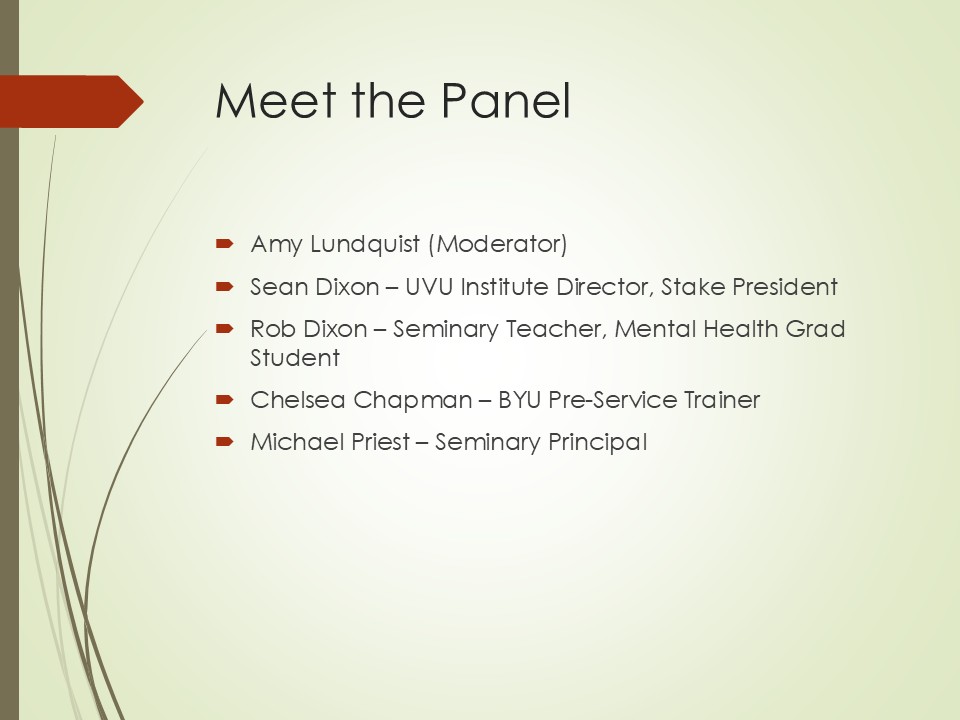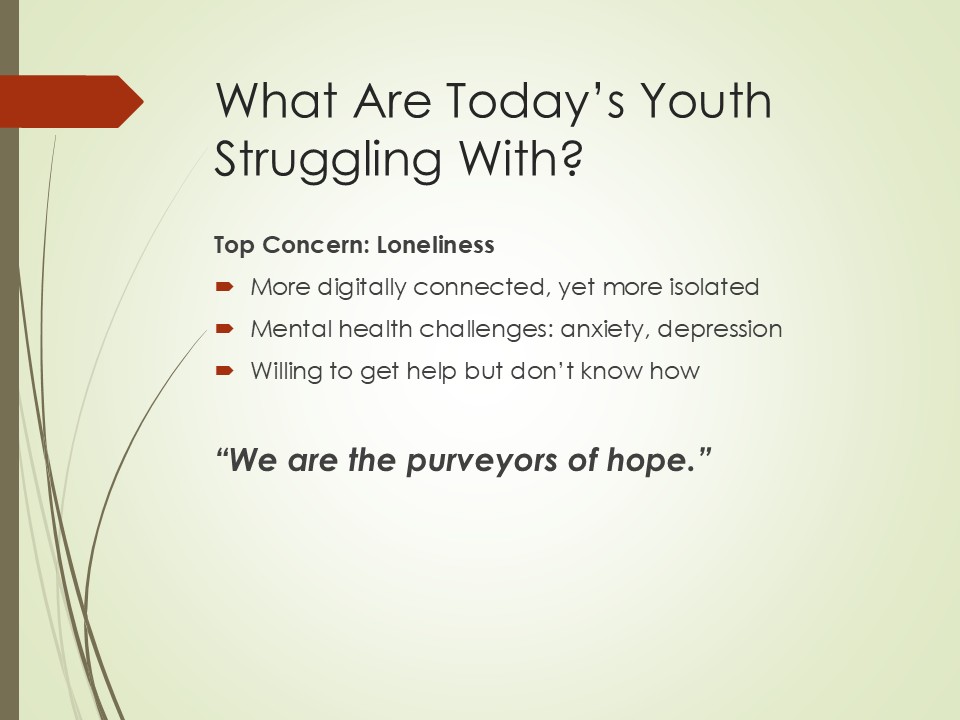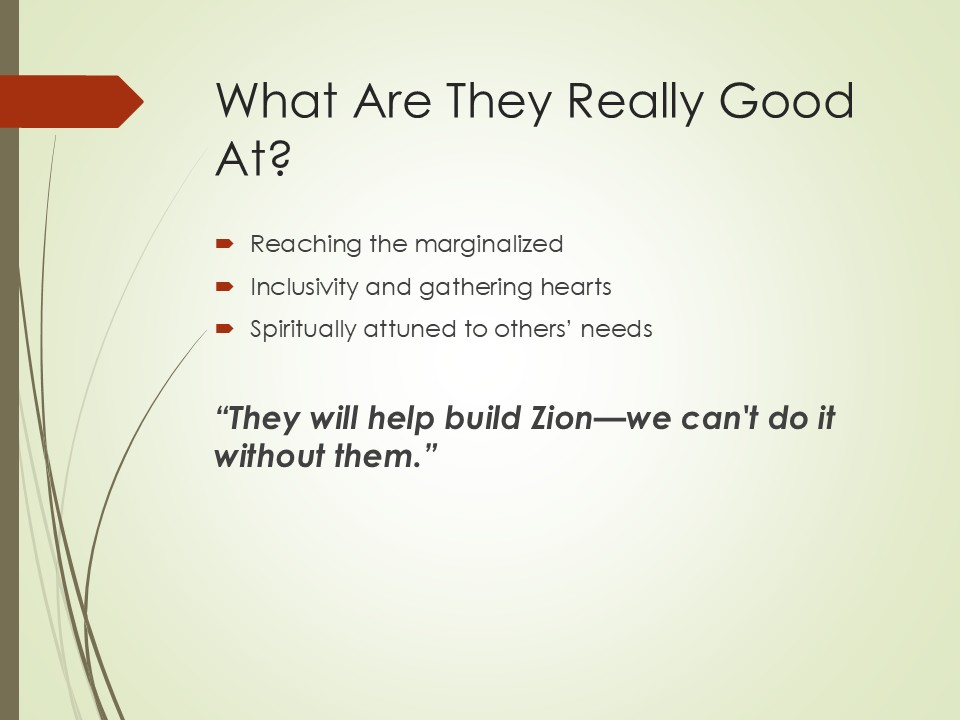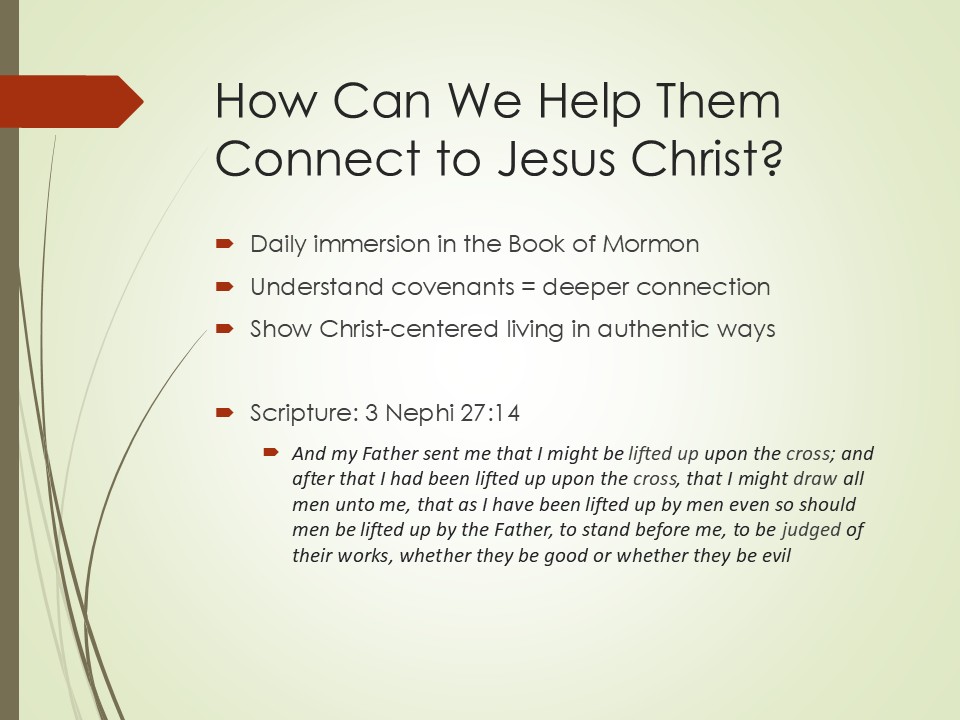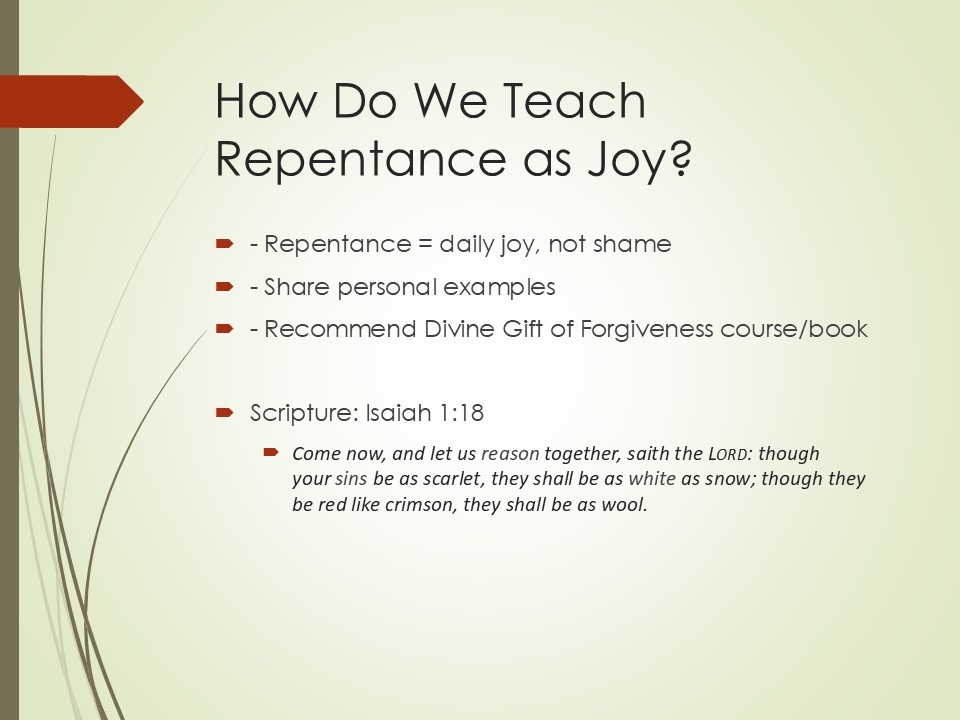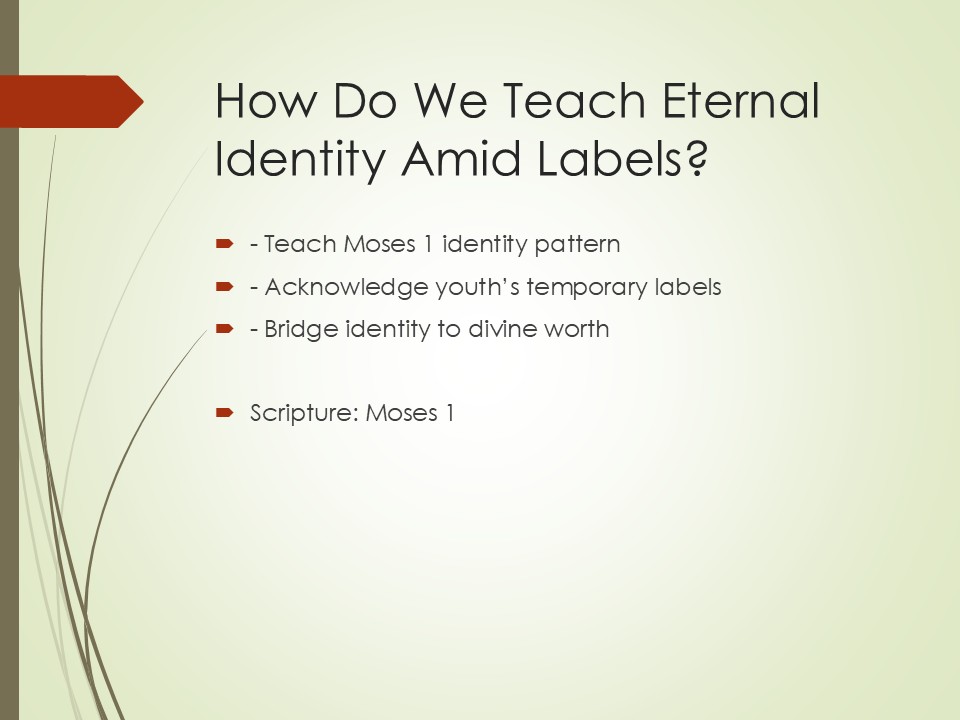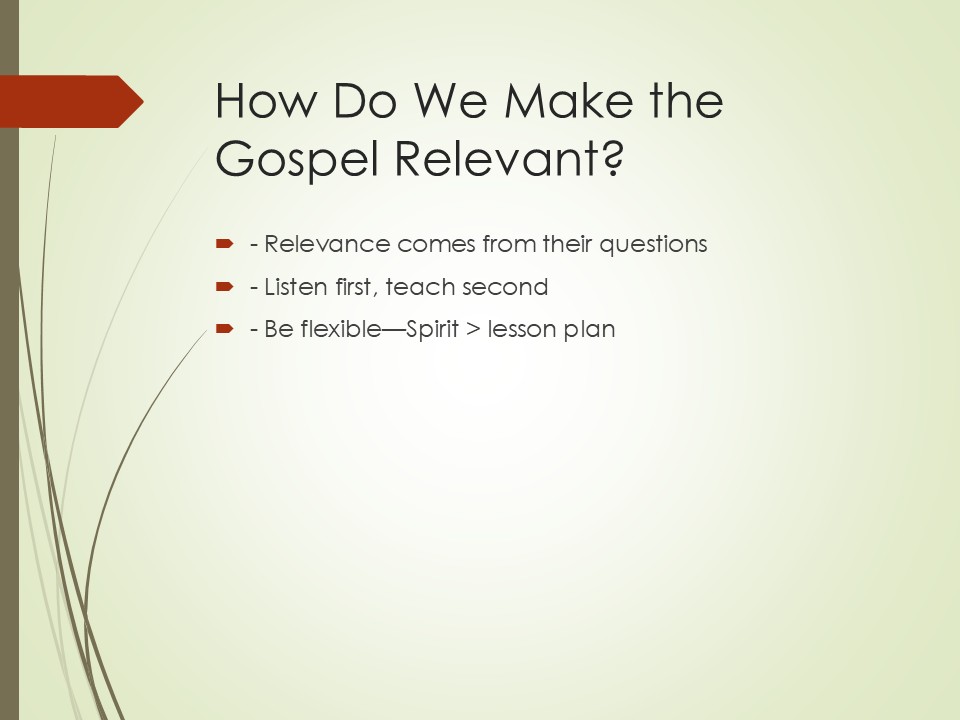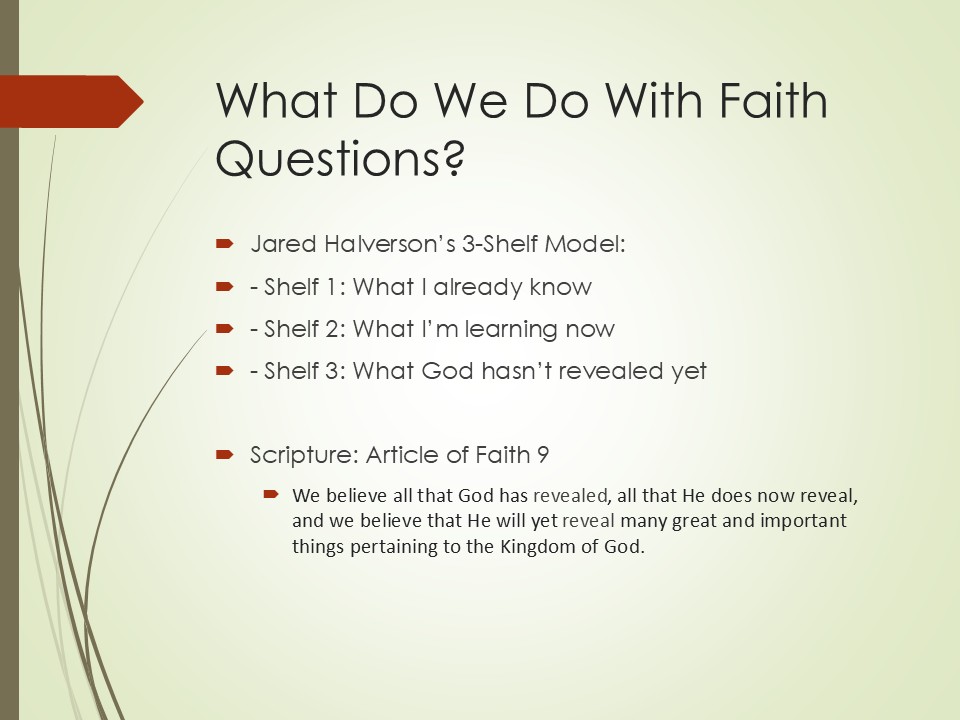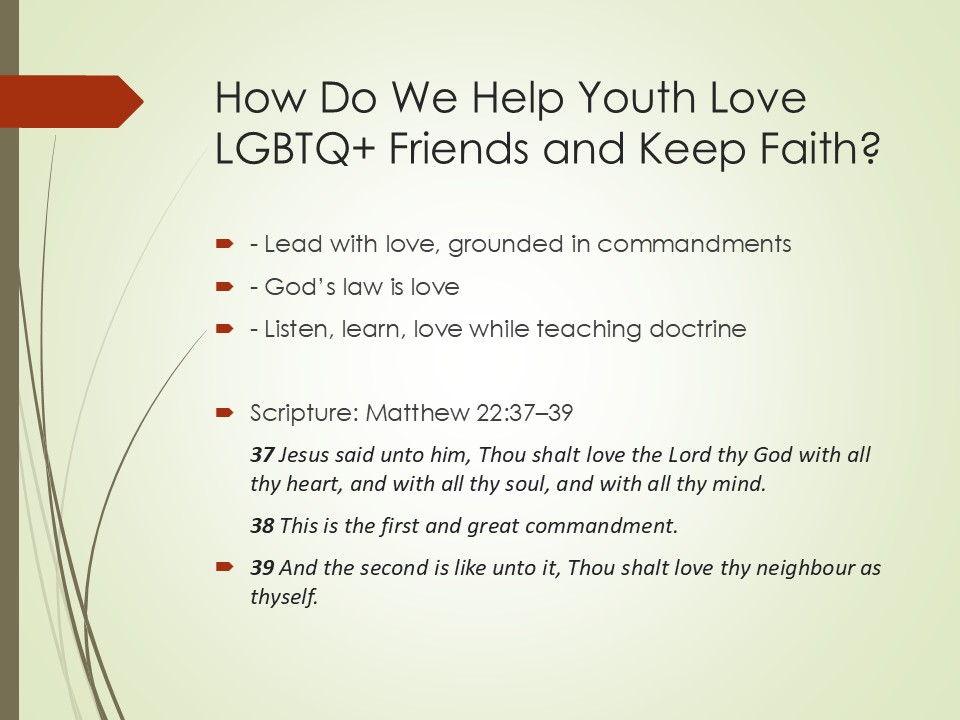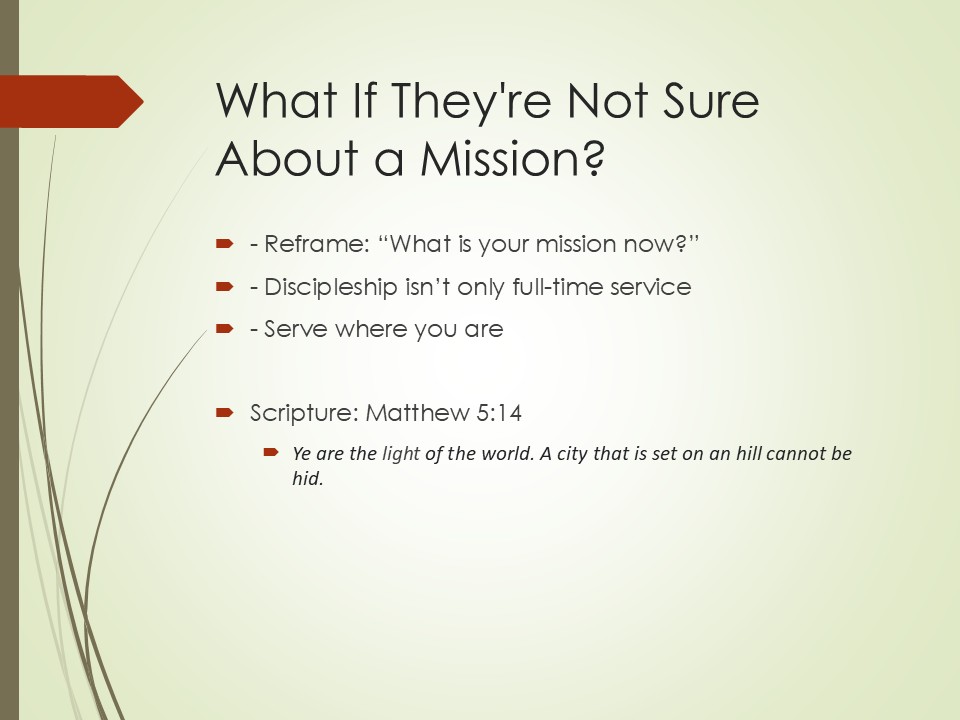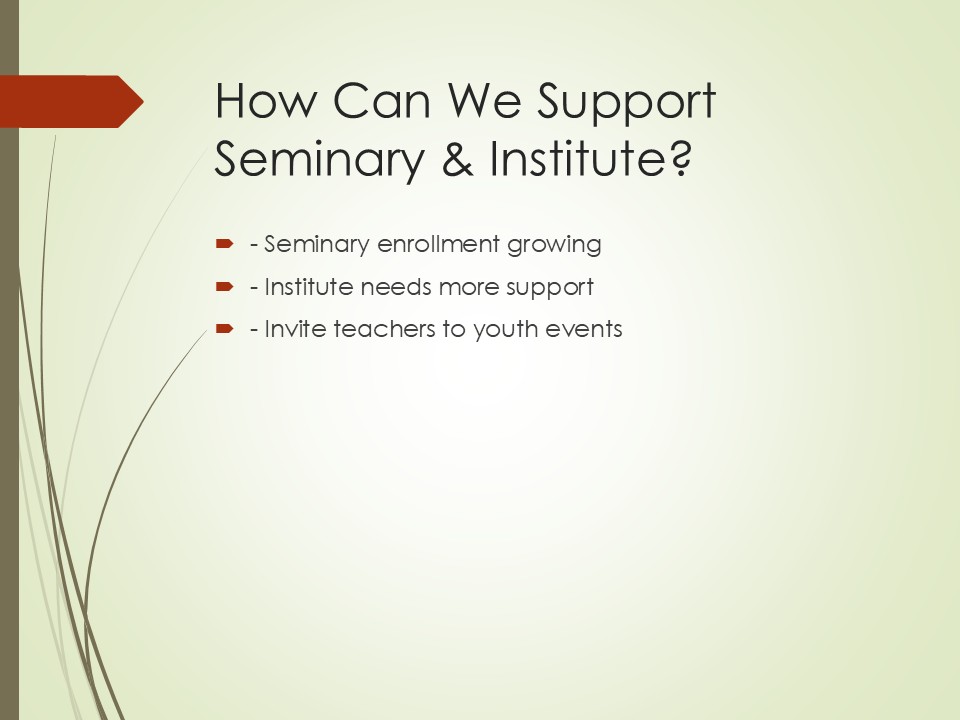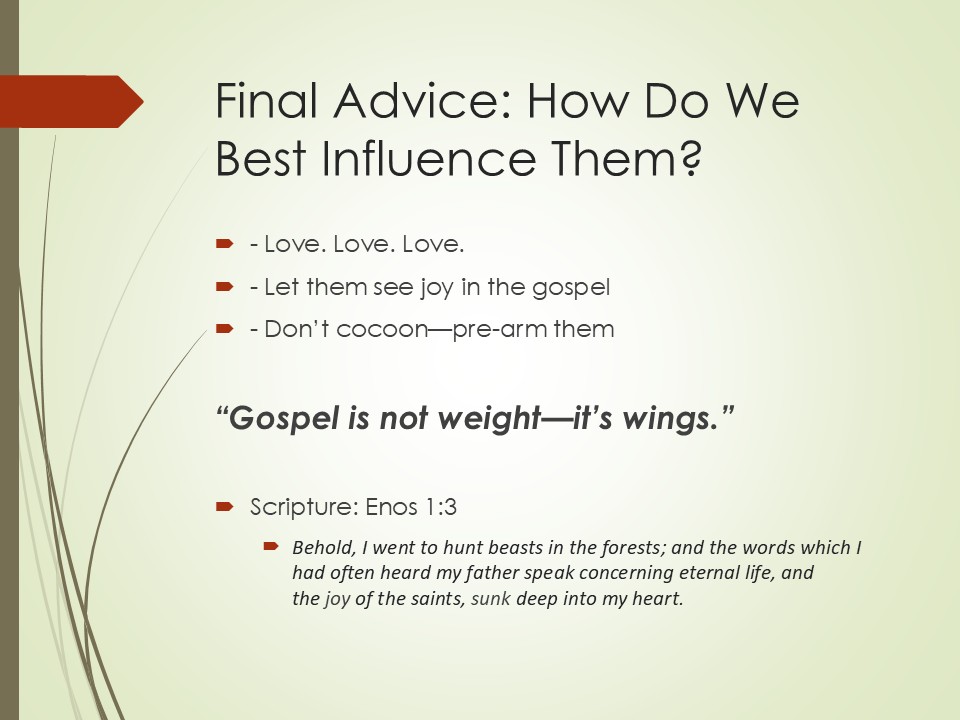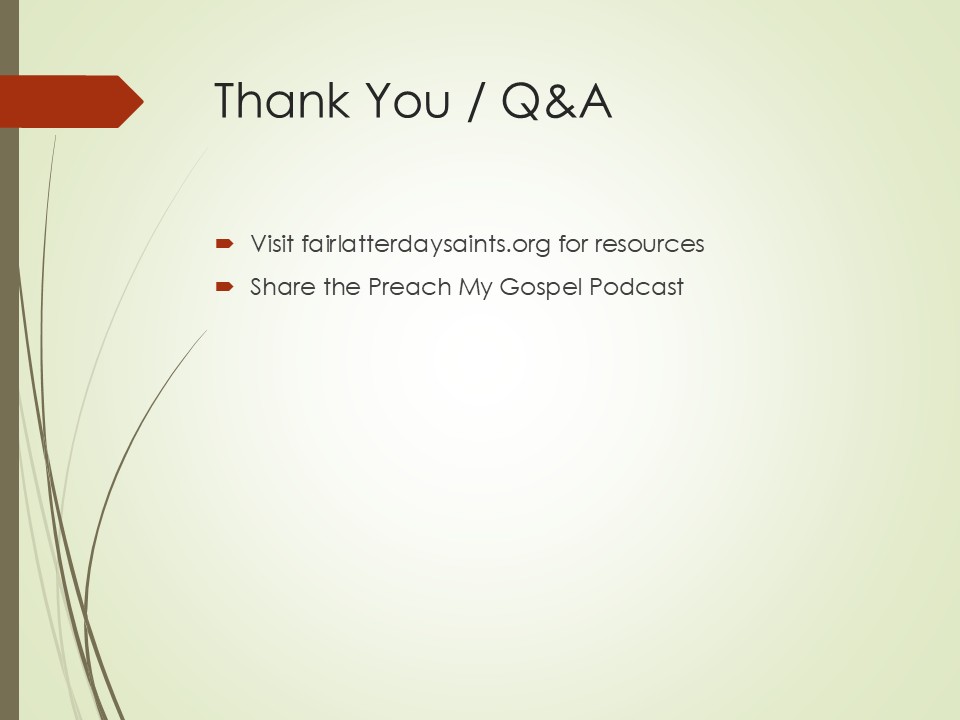Summary
Veteran Seminary and Institute instructors discuss how to help youth and young adults strengthen their faith, navigate identity and mental health challenges, build covenant relationships with Christ, and find joy in gospel living.
This talk was given at the 2024 FAIR Annual Conference at the American Heritage School, Salt Lake City, Utah on August 8, 2024.
Chelsea Chipman
Chelsea Chipman is a Seminary principal in Provo, Utah, with nearly 14 years of experience teaching in the Church’s Seminaries and Institutes program. She holds degrees from UVU and USU, served a mission in the Czech Republic, and has a deep love for the youth and young adults of the Church. In her spare time, she enjoys pickleball, concerts, travel, and time with family and friends.
Rob Dixon
Rob Dixon is a Seminary teacher at Provo High with three years of experience in the Church’s Seminaries and Institutes program. He’s currently pursuing a master’s in Clinical Mental Health Counseling and training to become a therapist. Rob and his wife, Lydia, have a young son named Walker and another baby on the way. They enjoy sports, cooking together, and spending time outdoors.
Sean Dixon
Sean Dixon is the director of the Utah Valley Institute Region and has served in Seminaries and Institutes for over 30 years. He and his wife, M’Shelle, presided over the California Redlands Mission and he currently serves as a stake president in Spanish Fork. They have five children and three grandchildren. Sean loves teaching the gospel, cheering for the Utah Jazz and BYU, traveling, hiking, and playing yard games.
Michael Preece
Michael Preece has taught in Seminaries and Institutes of Religion for 18 years and currently serves as a seminary principal in Utah County. He and his wife, Caitlin, have been married for 17 years and have four energetic children. Michael loves teaching the scriptures—especially to youth and young adults—and has come to deeply understand God’s love for all His children through his years in seminary.
Transcript
Amy Lundquist:
My name is Amy Lundquist, and it is such a privilege for me to be here today to introduce and moderate this incredible panel of Seminary and Institute instructors. These four individuals have a combined total of over 65 years of experience teaching youth and young adults.
As we talk today about fortifying faith in teens and young adults, you’ll see we’re really in for a treat with them. You can click on their bios to get all the details about their interests and their families and things like that. I’m just going to give you a little snippet of information about them professionally, so you’ll understand how incredible this panel is.
Introducing the Panelists
If you’ll raise your hands as I introduce you so they know who you are—first, we have Sean Dixon. Sean is the Director of the Utah Valley Institute Region for Seminaries and Institutes of Religion. That might be the longest job title I’ve ever read in my life. But I know Sean very well, and I can tell you that job title translates into doing a lifetime of good for a whole lot of people, especially the youth.
Sean has been an instructor and administrator in Seminary and Institute for the last 30 years. He and his wife Michelle presided over the California Riverside Mission from 2016 to 2019, and Sean is currently serving as a stake president.
Next, we have Rob Dixon. Now, I don’t know if you noticed the similarity in the last name here, but how fun is it to have a father-son duo on this panel? It’s pretty amazing. Rob is the newest of the teachers on the panel, as you probably have guessed. He has three years of teaching experience and is currently at Provo High School. All of his teaching has been in Utah County, and Rob is currently in the master’s program in Clinical Mental Health Counseling and training to become a therapist.
Next, we have Chelsea Chapman. She has worked as a full-time instructor in the Church’s Seminaries and Institutes program for nearly 14 years. She was recently serving as the seminary principal for Provo, and she now has a new job—she is the pre-service trainer at BYU for teachers and new seminary instructors. She served a mission in the Czech Republic and says she absolutely loves the youth and young adults of the Church with all her heart and truly believes in each one.
Next, we have Michael Priest. He has been a teacher in the Seminaries and Institutes of Religion for what he calls 18 wonderful years. Brother Priest is also currently serving as a secondary principal in Utah County. I have to tell you—several of my children were privileged to be in Brother Priest’s class, and so his name is revered in our household. They absolutely loved him. Brother Priest says that he loves to teach the scriptures to anyone that would listen, especially to youth and young adults in the Church. His years in seminary have taught him of the extensive love God has for all His people.
So you can see why I’m so excited for this power-packed panel of Seminary and Institute instructors.
Let’s get started with our questions. I have encouraged them to answer the questions directed at one of them, but then all of them can chime in as well.
Let’s start with:
What are today’s youth struggling with?
Amy Lundquist:
What do you see as the biggest, most pressing spiritual challenges facing youth and young adults today? And relatedly to that—what is the rising generation really good at? In what ways do their unique gifts qualify them to prosper spiritually in this time?
Michael Preece:
Thank you. If I could answer that, like, for real and give you the full answer, then—man, I wish I could. But here’s what I’ve observed and what I feel is perhaps the biggest challenge that our youth and young adults face. And I would term it as loneliness.
They’ve never been more connected, and yet they’ve never been more lonely.
There’s a lot of data there. I don’t know if we’ll go into all the data, but there’s a lot that shows how many of these young people struggle with anxiety, depression, and just general loneliness—sadness. That is a challenge that they face in their lives.
A resource, if you’re interested in looking at it—I did some study on this just this week—the state of Utah has done a study over several years called the Student Health and Risk Prevention, or SHARP, study. I don’t know if you’re aware of the SHARP study, any of you. But they survey sixth graders, eighth graders, tenth graders, and twelfth graders, and it’s their data.
In 2023, they surveyed 52,000 of the young people in Utah. And here are some things that they said:
- 25% of them feel isolated.
- 80% of the kids spend two or more hours per school day on video games, texting, and social media.
- When they have a chance to be together, they’re spending an average of two or more hours a day not being together.
Regarding mental health:
- 25% of them say, “I have high need for mental health support.”
- 27% say moderate need.
So that’s over 50% of our young people saying themselves, “I need help.” The good news is, 80-plus percent of them say, “I’m willing to get the help I need.” So—they feel isolated. They don’t necessarily know how to get the help, but they’re willing to receive it.
So that’s a challenge they face. Maybe the biggest challenge they face.
What are they really good at?
Sean Dixon:
Okay, as far as what they’re good at— a lot. In particular, they’re really good at reaching out to the marginalized. They’re really good at that. They see the needs of others, and they’re willing to accept and love, which is really cool.
It’s interesting, though, that even the non-marginalized still feel lonely. But they do look out, they reach to love others, and I think that’s an exceptional skill that can be used to increase and strengthen their faith in the Savior.
Chelsea Chipman:
Amen. In my research, the first word that also came to my mind was loneliness.
I asked students at Timpview High School last year—students on the seminary council, whom we look to for so many things—and it shocked me. A kid comes to my mind, I’ll call him Sam 1. Sam said—and I thought Sam just had it all, right, in high school—and he said, “I’m lonely.” I’m like, “Really? You are?” He said, “Yeah, I’m lonely.” And he just said, “We’re all… I don’t know why, but we’re all lonely.”
So that’s really interesting to me—that we didn’t prep together, and loneliness was what came to my mind as well.
So whatever we can do to help them have deeper friendships, I think programs like FSY help a lot, actually. If we can help our teens go to some of those extra things—if they can get there—they come back and they talk about the friendships they made. They feel deeper friendships than sometimes the surface-level ones online or through text, which can be a little bit more superficial.
One of their greatest strengths is that they are the greatest gatherers. They have just come with a gathering heart. Because of the internet, they are aware that there’s a whole world out there—more so than when I was a teen. I think I was a little bit more in my world, or in my Utah world, or you can call it whatever you want.
The teens today know that there are so many people out there. They know Tokyo, Japan, exists, and I think that’s really cool. They have this inclusive, loving heart for all. They will gather Israel, and they will help build Zion, and we can’t do it without them. So I love their gathering heart.
Covenants Connect to Christ
Okay, perfect. Let’s start with you, Chelsea, on this one: How can we help youth and young adults find safety in the teachings and Atonement of Jesus Christ? And what advice would you give us as parents, leaders, and friends to help the youth learn that Jesus Christ is their individual Savior?
Chelsea Chipman:
I love that question. What comes to mind for parents, grandparents, leaders, and all who are listening is: read the scriptures with your teens and with your young adults, if they’re still with you.
President Nelson, in his talk Embrace the Future with Faith—I just recently re-listened to that talk. It’s powerful. If you haven’t read it recently, I would highly recommend it.
President Nelson talks about the power of daily immersion in the Book of Mormon. I know it’s nothing new, but sometimes we need the reminders. There is so much light and power in the Book of Mormon. It testifies of Jesus Christ more than any other book, and it will help build faith in the youth as they study the teachings of Jesus Christ. It will help build faith in the Atonement of Jesus Christ as we immerse ourselves more in the Book of Mormon.
That is one thing I’d say: Please keep reading at home with your kids.
Sean Dixon:
I think one thing is that a lot of the youth like to talk about Jesus—they like to praise Jesus—but maybe we can help them understand how they can be connected to Jesus.
In the last General Conference, the word covenant—I have a friend who did a little word search—and the word covenant was mentioned 224 times in 27 of the 32 talks.
So if we’re listening to prophetic priorities, our prophets are saying it’s more than just adoring Him, more than just talking about Him. It’s: how do I connect myself to Him?
We have the doctrine of Christ, which teaches us to exercise faith in Jesus Christ, to joyfully repent of our sins, to make covenants, and to follow the Holy Ghost. Those are the actual ways we get bound to Him, rather than just talking about Him and using His name.
It’s: how do we get bound to Christ?
And what I’ve noticed is that as our youth get bound to Christ, they no longer compartmentalize their lives—where they think, “Yeah, on Sunday I’ll be focused on Christ, but when I’m hanging out with my friends, I’m not thinking about Him.”
Wouldn’t it be awesome if they could be disciples all the time? So in my friendships, at work, at school—no matter what I’m doing—Jesus Christ is the center of the way I interact with other people.
I think a lot of that comes through that covenantal, deeper relationship with Him.
Rob Dixon:
Can I just give a quick case study of how I’ve seen that happen? And this is from my own personal relationship with Jesus Christ.
The question is: how can we increase that and support and strengthen youth and young adults in that process?
I remember—I’m thinking of the words of Elder Bednar when he said to “protect the private moments of your life” in this last General Conference. And those words have just been sitting on my mind and heart the last couple of months.
I remember—and maybe this goes against the idea of protecting the private moments—but I remember listening through the door, hearing my mom talk to and counsel with her best friends and neighbors and the people that would come. The way that she spoke about the Savior in those moments changed everything for me. It changed everything for me when I was in high school.
And again, maybe I was violating some privacy there, but I remember her testifying of the Savior and just deeply wanting that. And I know sometimes it’s hard to have those authentic opportunities to share your relationship—who the Savior is and how that covenant is changing you—but taking any opportunity matters.
I had a good friend in high school that did the same thing. We’d be sitting at Sonic and she’d say, “Jesus really actually helped me today.” We were just sitting there eating something and we were all like, “That’s weird, don’t say that,” at first. She said, “You guys, I know I’m weird, but seriously, I needed Him.” And that authenticity—it changed my desire to find that connection with Him.
Amy Lundquist:
I love that. Thank you, Rob.
Michael Preece:
Can I make a quick comment on that? Elder Christofferson was talking to Seminary and Institute teachers when he said this—but I think it applies to all of us. He said this to instructors, and I hope you kind of put it into your lives as well.
“We are not looking for Seminary and Institute instructors to become counselors or mental health specialists. Rather, we provide a counterweight to the factors in which society contributes to the increasing levels of anxiety and depression. We are the purveyors of hope.”
That’s what I think we need—to teach a hope-filled, hope-living gospel to these young people. Because then they want to be connected to Jesus Christ, covenantally and beyond. And so I just see myself now as a purveyor of hope for these young people. And I hope we all do.
Amy Lundquist:
I love that.That’s a perfect segue to our next question. Rob, how can we discuss repentance in a way that helps youth and young adults understand the joy?
Rob Dixon:
I think we’re all trying to do this in the Church, and I think we’ve seen some cool things happening just in the language that we use and the way that we approach it. I think that’s one of the biggest things we’re all worried about every day—and any person would be.
Looking at this question, before it was even asked, this verse came to my mind. It’s a very famous verse we all know—3 Nephi 27:14:
“My Father sent me that I might be lifted upon the cross, and after that I had been lifted up on the cross, that I might draw all men unto me, that as I have been lifted up by men, even so should men be lifted up by the Father to stand before me, to be judged of their works, whether they be good or whether they be evil.”
If you’ve read that scripture, the phrase draw all men unto me is there. When students—when youth, when people, when all of us—really start to understand who the Savior really is (in the scriptures specifically, which is our best source, but also through other people and experiences), there’s this legitimate drawing power.
So how do you find the joy in repentance?
He walked, and He did all that He did, because He wanted that drawing power to be there. It’s not just a last-ditch effort. I try to explain thisi—it’s not just “in case you make mistakes.” He did it ahead of time to initiate that drawing.
And I think this covenant relationship that we talk about—He wants that relationship. And one of the things He’s done—His Atonement—was for that: to initiate that.
I don’t know if that makes sense, but…
Amy Lundquist:
I love that explanation—that it wasn’t plan B. It was the plan. I love that. Sean, let’s start with you on this one.
Chelsea Chipman:
I just want to add one thing to helping youth and young adults find the joy of daily repentance. Of course, President Nelson has invited us to find the joy of daily repentance, which I’ve wrestled with and like, how do you do that, right? And so if it’s on our minds as parents and leaders, first of all, I think that’s really beautiful.
And don’t hesitate when you feel to share an experience with your kids of when you have felt the joy of repentance. It’s something we all need and experience, and there is joy in repentance and forgiveness. And it is awesome.
And a plug for a really great institute class that is called The Divine Gift of Forgiveness—it’s one of the greatest, in my opinion, classes offered right now at most institutes. And if it’s not offered at yours, the curriculum—correct me if I’m wrong, Brother Dixon—the curriculum is on your Gospel Library app. Just follow, you can go “Books and Lessons” and then “Institute.” Just follow those institute icons in your Gospel Library app.
The curriculum for The Divine Gift of Forgiveness is at your fingertips. You can use that curriculum in your homes if you want to as you’re teaching your kids and grandkids. And it’s really, really powerful and helps us realize the joy of repentance and forgiveness.
Michael Preece:
I want to share something too—just a quick story. Last night I was sitting in my bishop’s office with my eight-year-old, who was going to be baptized on Saturday. My youngest. Super excited for this event.
And my beautiful, wonderful bishop was just sitting there meeting with my boy, talking to him. And he said, “Owen, if Jesus was here right now, what would He say to you?”
And I was just like, what’s he going to say, you know?
And he said, “Come unto me.”
And I think all of us need that. All of us feel that.
I love Isaiah 1:18, right? Though your sins may be as—you know, the sins are scarlet—they shall be white as snow, etc. But the first two words of that verse are ‘come now’. I think that’s what we need.
We need to teach a God, who wants them there. That there’s no shame. There’s no judgment—well, there is judgment, but it’s the holy version. It’s the judgment of love.
And if we can help our young people—and all of us—have an image of God that’s that, that when you say, “What’s Jesus going to say to me?” Come unto me.
That’s the Jesus and the God that we need to help our kids feel.
Sean Dixon:
And that institute class is based on the book by Elder Anderson called The Divine Gift of Forgiveness. So if you haven’t read the book, that book is phenomenal. As a stake president, I have stacks of them, and we pass that book out like candy.
It definitely gives the right—the feel that repentance is a joyful choice. So it’s great.
Amy Lundquist:
Thank you. Perfect. Sean, keep the microphone with you, okay? The next question is: It seems that in our current society, labels are sometimes embraced like badges of honor. And there are a lot of labels out there.
What methods have you found that help instill in youth their identities as children of God, children of the covenant, and disciples of Jesus Christ?
Sean Dixon:
We just have to listen to President Nelson, right? President Nelson does that so well.
But the method that I like to use on this is to go to Moses chapter 1. I think probably most of you are familiar with that chapter, but it’s—it’s such an amazing thing to see Moses go up on the mountain.
He has this—this beautiful encounter with God. And—and as he’s there, he finds out his beautiful identity—that he is a son of God. And then he’s told, not only are you my son, but you’re in the similitude of my Only Begotten. There’s another really significant thing that he learned about himself.
And number three—I have a work for you to do.
So Moses is just like, “Wow, this is—this is nothing that I had ever supposed.” And he saw the greatness and glory of God and then recognized, “Woah, I am related to Him. I can become like Him.”
And then immediately what happens? As the vision departs and God leaves, Satan comes along, right? And what does Satan call him? “Moses, thou son of man.”
Right? What had God just told him? “You’re the son of God.”
And so I just think it’s so fun to see how Moses responds to Satan. He immediately recognized the difference in the light that he saw because he first understood his identity.
When our youth understand who they are, and then the temptation comes and Satan comes to make them feel bad about themselves, to create doubt in their hearts, they can go back and say, “Yeah, you’re coming with the 60-watt bulb, but I was just in the presence of 6 billion gigawatts,” right? I can see the difference!
And so he was able to say, “Get thee hence, Satan.” And then Satan ramped it up further. And he says, “Get thee hence!”
And at the moment when Moses was about to cave in, that’s when it says in the scriptures that—that he called upon the Lord. And when he called upon the Lord, he knew his identity as a son of God. He called upon God. He received power.
And says one last time, “Get thee hence.” And then we see Satan is now the one reeling and the one leaving.
So I think that chapter is just a really fun chapter you could read with your family or with an individual who might be struggling with their identity—to see the power to resist Satan.
When we understand who we really are.
Chelsea Chipman:
Just real quick on that—there are a lot of labels, and some of our cute teens and young adults choose a label that is everything to them at this season in their life. Maybe they’re like, “I am a soccer player, and that is my life. I eat, breathe, drink soccer, and I’m a soccer champion, and I’m a state champion at soccer—soccer, soccer, soccer.”
That’s awesome. It really is.
We know some labels are eternal. We know some are temporary. And so I would just say, continue to treat the teens and young adults that you love as the children of the covenant that they are. Treat them that way. Treat them for who they really are. And acknowledge the labels that are very, very important to them right now.
“You are an awesome soccer player, bud. And you’re such an awesome child of God.”
In my personal experience, when I haven’t acknowledged a label that’s been really important to maybe one of my teenagers—just in my life—or I refuse to acknowledge the label that’s so important to them, it puts a wedge. It’s put a wedge between us.
Like, “Why don’t you acknowledge my awesome purple hair?”
So I think this is something we can take to the Lord in our personal situations. But often, for me, I might acknowledge that: “Hey, I like your hair.” “Thank you.” “And you’re such a beautiful daughter of God.”
So I don’t know if that helps, but that’s just something that’s come to mind.
Amy Lundquist:
Thank you, thank you. Brother Preece, hold onto that mic.
Let’s continue. Oftentimes one of the most challenging aspects of teaching the gospel to youth is showing how it is relevant in their lives. What are the tips and tricks that you’ve learned over the years for making gospel learning relevant to the youth?
Michael Preece:
Great question.
I think the first step is actually: listen. Relevance isn’t what you think is important. It’s what they think is important. And the first step is listening.
Real relevance comes out of their experience—what’s on their minds, their hearts, their world. There are times—and I still do this all the time, and I’m trying to get better at it—and it’s actually really hard to be really relevant all the time. So let’s be real, because that’s hard.
But the best teaching experiences come when it’s coming out of their life experience, not my own. Get them talking, and you get listening, is where real power, I think, comes in the life of a teenager. And that’s when the dots connect about the gospel in their lives.
I don’t know if they want to add…
Rob Dixon:
Case study—twenty-second case study here.
This last semester, I go throw up the PowerPoint slide: “We’re going to practice this skill.” And I—this is the situation. They start doing it. They start practicing. And it’s just lame.
And I’m getting a little bit—angry is not the word—but I’m like, “Okay, why aren’t you guys doing this?”
And I go up to a couple of these girls, and they’re like, “This is the dumbest thing I’ve ever read.” Right? And I had crafted it up.
And so my pride is hurting, and I’m like, “I thought this was like—you guys were going to vibe with this.” Not at all.
And again, I’m only a few years older than them, but sometimes it can show, right? And then I said, “Well, what would you do?”
And they said, “Well, first, you know…” and they went off into this thing.
And I paused everyone and I said, “I’ll just give it to Susie,” or whatever—no one’s named Susie these days—whatever. “Jane is going to tell us the actual story.”
She did, and the energy in that room changed.
Amen to what you’re saying. Let them – pull it out of them. And when you listen—
Sean Dixon:
I’m loving that you were willing to flex with the class. Willing to, like, say, “You’re right. This is lame. Let’s—let’s try it another way.”
Because I think what we want to do is—we understand we’re teaching people, not lessons. And I think when we get caught up in our preparation—like, “I studied for six hours on this point I want to make, so you’re all going to listen to me”—versus, like, “You know what, that’s not really resonating. Let’s be flexible. Let’s follow the Spirit.”
And the best classes are the ones that just go completely different than—than how you had it prepared. But I think over-preparation sometimes creates inability to be flexible and relevant.
Amy Lundquist:
Thank you.
We’re told to doubt not, but we’re also encouraged to ask questions. So how do you walk the line of questioning—yes—but not questioning faith? And how do we teach youth and adults to do this?
Rob Dixon:
If you’re familiar with the Seminary and Institute programs—specifically the Seminary program—I don’t have the answers, but they have spent a ton of time on this process.
And so I would turn you to look at the Acquiring Spiritual Knowledge program that we use every single week, if not multiple times a week.
I’m just going to read a quote, and then I’m just going to pass it back to let them share anything else. But this is a quote that I don’t think solves all the world’s problems with this—or all the youth problems or anything—I think it’s helped to put things into perspective.
This is from Elder Neil Anderson, and this is what he said:
“Faith never demands an answer to every question but seeks the assurance and courage to move forward, sometimes acknowledging, ‘I don’t know everything, but I do know enough to continue on the path of discipleship.’”
That’s like my Captain Moroni title-of-liberty quote right now, as I’m navigating my faith journey—that we all are on.
Sean Dixon:
So, I—last week I was—I love that thought. I think maybe building on that—
Not last week, but maybe it’s been a month ago—we had the CES Religious Educators Conference. So all of the entities of Seminaries and Institutes and all the BYUs and Pathway and everybody came together for a conference.
And Jared Halverson was one of the presenters there.
And maybe some of you have heard this model before, but it was really insightful for me. He based this on the Ninth Article of Faith:
“We believe all that God has revealed, all that He does now reveal, and that He will yet reveal many great and important things pertaining to the Kingdom of God.”
And then he said, if you can just build three shelves…
A lot of times, we’ve had this idea like, “Okay, I have a shelf. Anytime I don’t have an answer to a question, I throw it up on that shelf.” And a lot of people that are in faith crisis have said, “My shelf is breaking. There’s way too much up on that shelf. It won’t maintain all the questions.”
He said, there’s actually three shelves. So the first one is based on that first thought: “We believe in all that God has revealed.”
On that first shelf is where I can put things that God has already told me in my life. Maybe it was that priesthood blessing I received, or that one seminary lesson where I just all of a sudden understood something clearly, or this moment in prayer where I felt God’s love, or that time on my mission when I just experienced the Atonement of Jesus Christ with somebody else.
So if we have a nice, well-stocked shelf one, and we record those things in our journal and refer back to them often—we don’t lose those things.
Often when people start really struggling is—they just ignore shelf one as if they’ve never had spiritual experiences.
So keep a nice, well-stocked shelf one.
And then shelf two: “All that He does now reveal.”
Sean Dixon:
Do we have holy habits and righteous routines where we’re seeking to hear God’s voice? Am I studying my scriptures and saying prayer and worshiping in the Lord’s house, and really trying to listen so that I’m actively—have an open line of communication with heaven where God can reveal things to me?
So I have a nice, well-stocked shelf one; I’m seeking revelation in shelf two.
And then, when I come across a question that I don’t understand, and it’s just like, “This is tough,” and this is maybe something that God just has not yet revealed—we don’t understand why this is the case—so I’m going to just stick that one up on shelf three.
But because I have a really well-stocked shelf two, and well-stocked shelf one, the things up on shelf three aren’t so heavy.
And what’s neat is—the Savior’s on every shelf, right? He’s—He’s there. He’s the one that gave us those early experiences. He’s constantly communicating with us now. And through His grace, He’s holding up shelf three and determining the best time to bring things from shelf three down to shelf two. Right?
Like, “Yeah, this one—wow. I didn’t think I’d ever get an answer to that question. And I just got it today.” That’s now shelf two. There’s a little more space up there on shelf three now for my next.
And it’s okay to have questions there.
And I think we need to normalize that for youth and young adults—and for all of us—that it’s okay to have unresolved questions. Like that quote Rob shared.
Part of it is what causes us to have to exercise faith. If God gave us answers to every single thing that we didn’t know about, we really wouldn’t have to exercise faith.
And so having that third shelf, I think, is a key part of God’s plan for us building faith in Christ.
Amy Lundquist:
Thank you. I love that imagery of the three shelves.
Chelsea, how can we help youth and their adults navigate the issue of loving and including LGBTQ friends while still honoring God’s love?
Chelsea Chipman:
Well, thanks for that question.
So I’ve had the privilege the last three years to teach a workshop at the Utah Valley Institute for LGBTQ+ students and their friends and those who love them. And so, my heart is full for our LGBTQ students and our kids.
And, if you’ve never talked to an LGBTQ+ teen or young adult, I would encourage you to listen to their stories, because it’s changed me just to seek further understanding.
I think sometimes in the past I’ve worried about, “How can I, right, be true to God’s laws but be kind and loving, too? How can I defend the proclamation but still—”
And I’ve just reached a point where I’ve found a lot of peace in the two great commandments—that I get to love God, and I get to love all of His children.
And I know it’s not that simple. But I think for those who are struggling to find the balance—how do I help youth and young adults navigate the issue of loving and including LGBTQ friends and honoring God’s laws, I would say: God’s law is love. The first two great commandments are about love.
And I—I often, in situations I’m in, I recognize my role. I’m not the Savior. I’m not the bishop. Maybe some of you are. So you’ll have to navigate that in conversations with your LGBTQ+ members and where they’re at.
I’m not their mom. I’m their teacher.
So I will teach the doctrine with love, and I will teach love—the two great commandments.
I don’t know how well I answered that, but my heart is—is that I love the LGBTQ+ young adults and teens very, very much, and would want to help more.
Michael Preece:
Amen.
My one thought is—I don’t know how to fully. I’ve just got—I’ve got to concede that I just—I’m incapable of fully understanding that complexity.
And I’ve found that when I am humble in that complexity, I’m actually a better instrument in the hands of God to help those in that complexity.
I do know that, when a member of the body of Christ is weak, we actually honor them with greater love—not less. That’s what Paul told us to do.
And I know many of you, if not all of you, have had conversations with individuals in that space, and you will shed tears with them, and you will ask questions.
But I do know this: that I know that God loves. And it will be okay in the end. And it’s not the end.
Amy Lundquist:
Thank you.
Amy Lundquist:
Sean, to you – What do you find most helpful in preparing youth and young adults to enter the temple, make covenants, and continue to worship there? And how can we better help them—and all of us, really—better understand and embrace the blessing of making and keeping covenants?
I love your mention of covenants previously, so help us understand and navigate that a little bit.
Rob Dixon:
Yeah, again, I think—I think just listening to General Conference, listening to the promises.
Listen to this. This was President Nelson’s prophetic promise from Conference:
“My dear brothers and sisters, here is my promise as a Prophet of God—nothing will help you more to hold fast to the iron rod than worshiping in the temple as regularly as your circumstances permit.
Nothing will protect you more as you encounter the world’s mists of darkness.
Nothing will bolster your testimony of the Lord Jesus Christ and His Atonement or help you understand God’s magnificent plan more.
Nothing will soothe your spirit more during times of pain.
Nothing will open the heavens more. Nothing.”
I think having a conversation about those promises and how much those promises are needed in the world—I mean, basically, he outlines every issue facing youth and all of us today—and being able to worship in the House of the Lord is the answer.
So hopefully that will create an anticipation and an excitement.
And then, I think secondly, we can say way more about the temple than we think we can. I think we’re doing way better now than we used to, but we used to be so worried about what we could say that the default was, “We don’t say anything.”
And if you take them to temples.ChurchofJesusChrist.org and just walk them through that website, you can see, “Oh, we can talk about that. Oh, we can talk about this.” And you realize almost everything—except for those things that exclusively we promise not to—we can talk about, so that when they go to the temple, they’re not surprised.
I think one in particular is the temple garment. You know, most people or people that are opposed to it or having struggles with it—it’s because they only think it’s just for modesty. This is the Church’s way of getting us to be modest.
And so, if that’s all you think the temple garment is about, then you’ve completely missed the significance of the doctrine of being covered by Christ. Right? He wants to give us a better covering that will completely cover us.
And I think when we teach that doctrine, then they can be excited about wearing the garment, rather than having it be this thing I have to do.
The last thing—I have a friend at the Institute who has done such a good job teaching this idea of, “Let’s—how about we call it the House of the Lord?” And think about: when you go to someone’s house, what do you expect to have happen there?
You expect to come to know the person whose house it is.
If we’re talking about it as the temple, it feels a little bit like this building. But if it’s the House of the Lord, when I go into that place, I’m experiencing the person whose house it is. And it’s a worship experience.
I’m coming to know God and Christ—rather than I’m just going through the temple, or I’m doing some work that I’ve been asked to do.
Instead, it’s about building this relationship with God. And I think that’s so much more enticing than “going to the temple.”
So, sorry—long answer there.
Amy Lundquist:
That was a great answer. Thank you.
Amy Lundquist:
Okay, Brother Prieece, you work daily with many young people who are either preparing to serve missions or returning from their missions. What do you think are the most challenging issues facing these young people, and how can we as parents, grandparents, neighbors, and friends support them—especially those who are struggling to stay engaged with the Church after they return from missions?
Michael Preece:
Wow, what a question, right?
I don’t have a—a great answer for that other than—I just—here’s the thought about preparing. I help—I deal primarily with young people preparing to serve missions at the moment.
And I think one of the things that I want to instill in them is that there is this—they want to meet a certain standard or a capability before a mission. And absolutely, we want to be the best possible missionaries when we hit the mission field.
But I love in Matthew chapter 5 when the Savior turns to all of us and says, “Ye are the light of the world.”
You’re already light.
I think sometimes we have a—a false sense of what light can actually do. And we feel like we have to have this incredible searchlight. No. God said, “You don’t have to meet any kind of requirement. You’re already my light.”
I love a poem by an ancient poet, Hafiz, who said—and I love this invitation, I’ve been trying to wear it kind of as a mantra in my life, like Rob was talking about. He said this—it’s love, the invitation:
“You could carry your heart through this world like a life-giving sun.”
You could.
And if our young people understand that missions and mission service is just an opportunity to be light, then I—hopefully the stigma comes down and the worries go down a little bit. That they could—if they wanted—they could be that life-giving sun carrier to the world.
And that can be service missions. That can—you know, like, there are so many options and opportunities.
And I just—I want to instill that in the young people. So that’s how I’ll answer that part of that question. If others have other wisdom, please.
Rob Dixon:
I—I sense—this is not everybody—but I sense that so many of the youth that I’m around all the time, they’re just frozen in the decision. And because we all have our reasons when we think about a mission—whether that is a service mission, a proselytizing mission—we all know that there’s a big variety there.
But there’s just like a sense of—they’re just kind of frozen. There’s a lot of expectation, or whether it’s felt, stated, or not. And there are some prophetic statements that make it—that are pretty bold, right, about serving missions. And I sense this—this feeling of like, “I’m frozen. I’m nervous about doing this part of it,” or “I feel like I can’t do this part of a mission, so I just don’t want to talk about it.”
And my mom, and that lady that’s two rows back that always sits there in church, is always asking me about my mission—and it just makes me want to run the other direction.
And I think we’re aware of that, right? But one of the things that I’ve found that’s so helpful—and you just taught it just brilliantly—and that’s just like: “What is your mission right now?”
Like, what’s—how can you use the light right now? And let’s not worry about the decision of if you’re going to serve in three years or not. Let’s worry about what we’re doing this week—in your high school, in your Young Men’s, Young Women’s group, or in your young adult circle, whatever that is.
What’s that mission right now? What’s your ministry? What’s your discipleship looking like?
If you can imagine being at a grocery store—I use this analogy because it’s helped me a ton—you’re at a grocery store, and you look down the aisle, all the way down the aisle, and there’s someone that drops a loaf of bread. I ask my students, “Would you run and go help that person pick it up?”
And they’re always like, “Well, depends. How old is the person?” And then we go off, right? But when we get down to it, no one is going to sprint down and help with the bread, right? The problem is often the distance, and it doesn’t seem like there’s a huge need to it.
And then I say, “What if right next to you, somebody accidentally bumps the shelf and jugs and jugs of milk fall over and they’re exploding, and you’ve got milk on your face, and they’re on the floor,” right?
So, are you going to help this person out?
And they’re like, “Well, duh, I’m going to help them out,” right? Like there’s no chance I’m not going to engage and support.
And I say, “How do you feel about the gathering?” Right?
Is it a distance? Is it down the aisle? “I’m not sure if I’d do it that way… might look weird if I did it,” right?
If a mission and the gathering feels like a down-the-aisle problem, we’re always going to be stuck in our head. And we’re not going to engage.
When our relationship with the Savior and the way we feel about how His gospel changes our heart—when that is, like, so compelling that it’s like a ten-jug milk spilling all over the place kind of a problem—we don’t ask questions about how we’re going to serve. We know we’ll figure out a way.
Right? Like, “I don’t know how to help you with your milk problem, but I’m in it with you.” And I feel that way about the gathering. When students, and when youth, and when I feel like the gathering is a big deal, and it’s a problem in the world, then I know—I’ll figure out a way how to help.
Amy Lundquist:
Thank you. And Sean, tell us a little bit about your podcast that dovetails with these two groups that we’re talking about.
Sean Dixon:
Yeah. Me and another teacher at the Institute—we both served as mission leaders in California at the same time. And we came home, and we’re just across the hall from each other.
And so, just in talking to each other, we—one day I just went into his office and we got to talking about helping to prepare people for missions. And I stuck my cell phone in between us and we had a little conversation.
And it kind of evolved into something called the Preach My Gospel podcast. Season one is for people preparing to serve missions. We have an episode for every week of the year—there’s 53 episodes for pre-missionaries.
And then when we finished that, we got thinking about all of our missionaries who had come home and who were struggling in their faith and having such a difficult time—and students that we have at the Institute.
And so season two is for the return missionary. And we’ve just had guests on, and we interview them, and they talk about different things that will help the return missionary continue to be lifelong disciples of Jesus Christ.
Amy Lundquist:
So thank you, I love that! Sean, while you have the mic, you’re the one to tell us, since you’re the one—you’re the director of all things seminary and institute.
Rob Dixon:
Oh wow. I didn’t know that. That’s—
Amy Lundquist:
Again, Institute enrollment numbers—up? Down? Or maintaining about the same?
And what do you think that we as parents, grandparents, friends can do to help youth understand this precious opportunity that they’re given in this little bit of time to attend seminary and have that daily immersion in the gospel?
Sean Dixon:
Yeah, it’s actually really good news, the answer to that question.
During COVID, there was a big decrease, but things have really turned around. In that same Religious Educators Conference, our administrator Chad Webb gave some statistics. So I’ll just read from his statistics.
He said we have grown by 5% in the last two years in seminary. This is significant progress, because despite the seminary potential decreasing by 50,000 students since 2018—so demographically the number of potential students has gone way down—but we’ve still increased the numbers by 5%.
The last year, we reached 54.4% of seminary potential enrollment, which is the highest percent we have ever reported. It’s up from 49% five years ago.
So, a little over half the potential students in the entire Church are taking seminary.
And then in Institute, there’s been a significant increase the last four years. We’ve been doing something called Innovate Institute, where we’ve really been listening and changing the way Institute is delivered according to the needs of students.
And we’re at over 20,000 students—we will have added over 77,000 Institute students over the past three years. So that’s really good.
One of the things that happens a lot with seminary is—it’s very much, parents really focus on “You’ve got to go to seminary. Got to go to seminary.”
And so there’s been a lot of emphasis on seminary—not so much with parental and priesthood support for Institute. So anything, I think, that you could do to just say, “Wow—as a priesthood leader, as a parent—to be able to put my student—either my youth in a seminary class or my young adult in an Institute class—where they’re going to be in a place where the goal is to gather people to the Savior, Jesus Christ?”
Like, why wouldn’t I do anything I could to get them there?
So anything you can do to help promote that—even though the numbers are up—there’s still so much potential of people that we’re not reaching that just don’t know what it could be for them. So, anyway.
Chelsea Chipman:
Just—I’ll be quick. I know we’re close on time.
But as a seminary principal, I really, really appreciated the Young Women leaders, Young Men leaders, bishops, and even stake presidents at times that would reach out to us—the seminary—and invite us to a Mutual night to come talk about seminary, or to have a fireside where we could talk about seminary and answer any parents’ questions about it.
And so that could be something that you could do in your ward or stake.
And we love it. I want you to know that—we love it when you invite us. We’re often knocking on doors in the summer and inviting kids to sign up for seminary, but it’s much more powerful when the home base invites us in.
And whether it’s a—again, Mutual, fireside, an activity—we can totally do an FSI kind of a thing. Whatever you want. We’re in.
And so, please invite us, and we will show up and answer all your questions and let kids know what seminary (and institute) is all about.
Amy Lundquist:
Thank you. Let’s do a rapid fire. One last question—30 seconds each.
Tell us, as an audience—here we are, being the mentoring generation of the children and youth that we’ve talked about, and the challenges that they face—what do you see as being our most effective way to influence them, to face the challenges they face?
Chelsea Chipman:
You probably know this already, but love, love, love, love, love them. And make sure they know you believe in them—through their best times and their worst times.
A teen and a young adult who has an older adult who believes in them—it will change them. And it will change their life.
Michael Preece:
That’s probably the best answer we’ll hear, but I’ll give a secondary answer.
I think of Enos. We don’t really know how sinful Enos really was. I think we assume more than we should.
But I love what he said. The thing that got him to the forest on his knees that day was that his dad constantly talked about the gospel. And he constantly talked about and modeled the joy of the gospel.
And so I love the gospel as a gospel of joy.
One of my favorite quotes is by Harry Emerson Fosdick, when he said, “The gospel is not weight, it’s wings.” And we live it joyfully—not burdensome. Then we become the model of the disciple we want our children to become.
Sean Dixon:
That’s so great.
I heard someone tell me this concept once, and I love it. It’s the difference between cocooning the youth and pre-arming them.
Cocooning—what we do is we coddle, and we nurture, and we protect, and we don’t let them feel pain or get hurt. We do things for them because we don’t trust them and don’t want them to fail.
And then what happens when they leave our presence? They really struggle.
The opposite would be to pre-arm them—to teach them the skills, to give them the—you know, help them to know how to turn to the scriptures or to the Lord for help, and not be afraid of what might happen if they make a mistake and have to learn how to repent, or they fail, or they’re not as prepared as they could have been.
Let life teach them lessons, and you be there to—to help give them skills, not just protect them from their falls.
Rob Dixon:
I mentioned this earlier—love the quote: “Protect the private moments of your life.” And I think that can totally be an individual thing, and also with those relationships.
It doesn’t have to be parent-child. Protect those moments. Be intentional about them.
We may not seem like we want them, but we do. We want those private moments with people we trust.
Audience Q&A
No Q&A was offered in this discussion.
Endnotes & Summary
coming soon…
All Talks by This Speaker
coming soon…
Talk Details
- Date Presented: August 8, 2024
- Duration: 50 minutes
- Event/Conference: 2024 FAIR Annual Conference
- Topics Covered: Doctrinal misunderstandings about repentance, covenants, and garments, Faith and doubt: navigating unanswered questions, The role of the temple and symbolic clothing, Youth mental health and gospel relevance, LGBTQ+ inclusion while upholding doctrine, Missionary service expectations and spiritual worthiness, Defining identity through eternal truths vs. cultural or social labels, The impact of daily gospel habits on resilience and faith anchoring
Common Concerns Addressed
coming soon…
Apologetic Focus
coming soon…
Explore Further
coming soon…
Share this article


